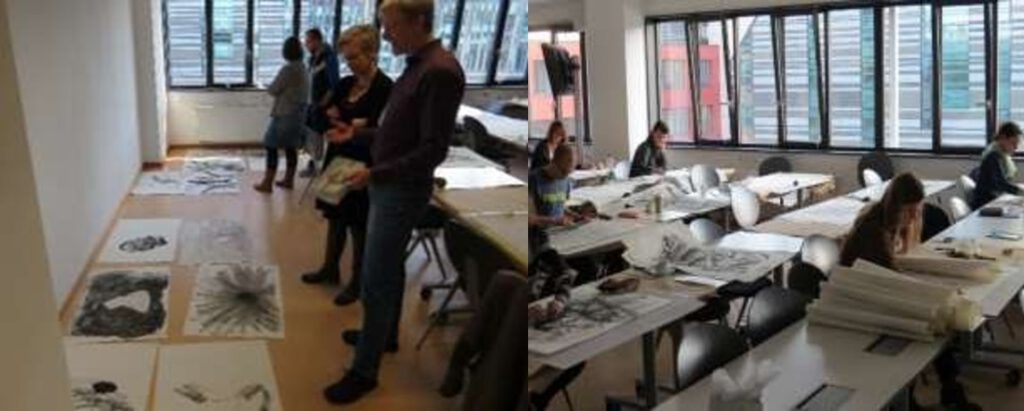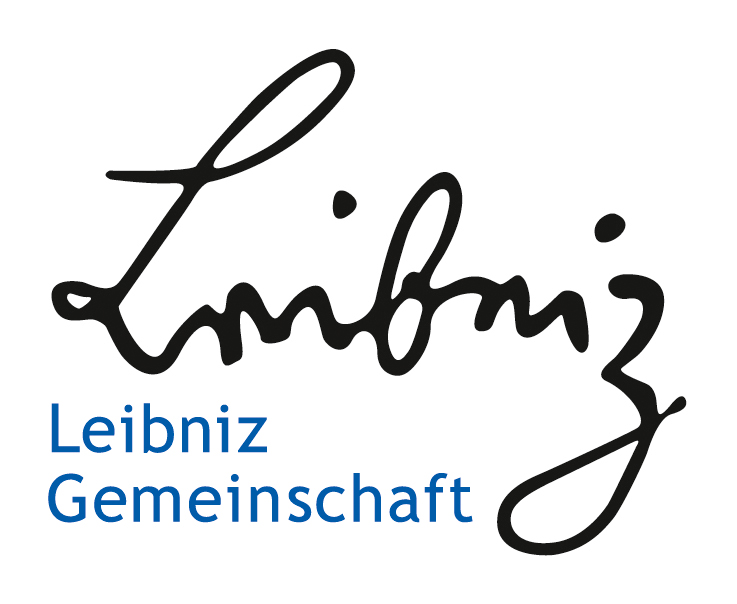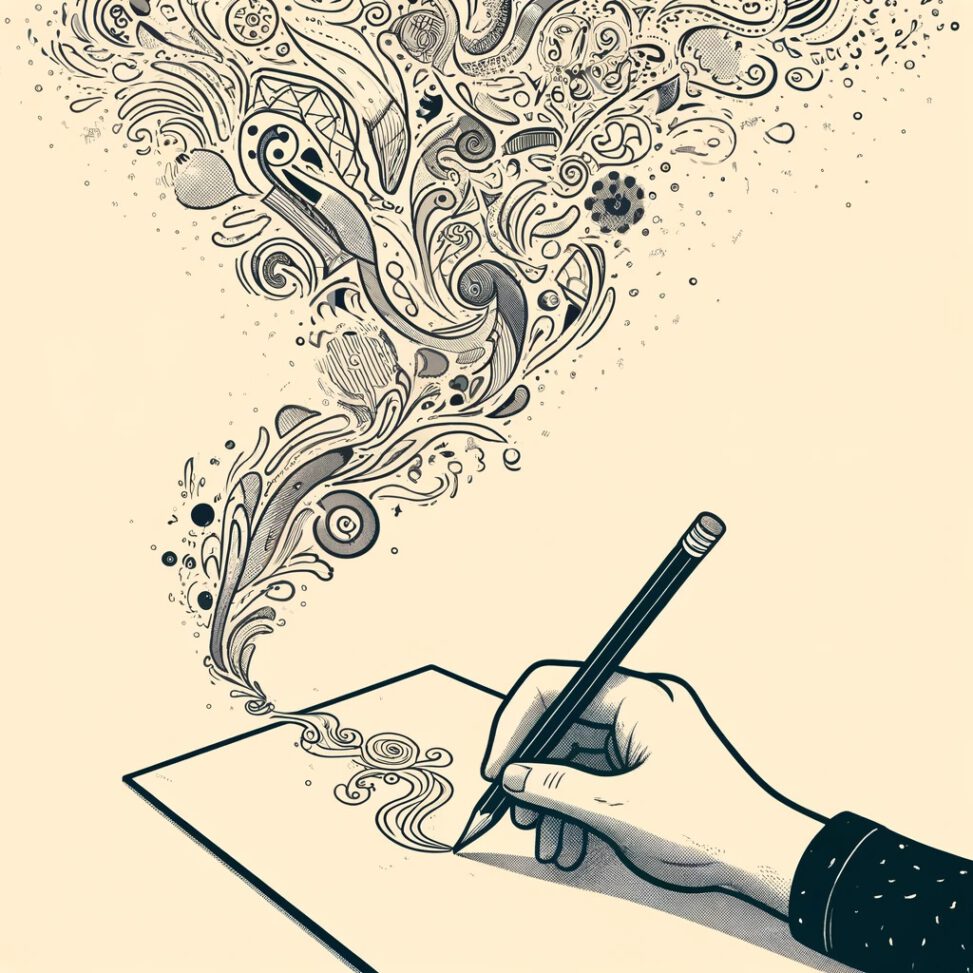On everyday productions of aesthetics via Self-Centred Drawing
Authors:
Mirka Dickel & Nicola Richter
Citation:
Dickel, M.; Richter, N. (2024): Doodling. On everyday productions of aesthetics via Self-Centred Drawing. In: VisQual Methodbox, https://visqual.leibniz-ifl-projekte.de/methodbox/2024/04/05/doodling/
Essentials
- Doodling is a pervasive human behavior observed during diverse activities such as phone-calls, restaurant waits, or conversations, occasionally manifests within the research process, and may appear in research journals, notepads, or scrap papers.
- Despite its often-dismissed status for lacking perceived artistic merit, doodling uncovers an unconscious dimension.
- We approach doodling as a visual and especially embodied practice (according to Merleau-Ponty) within the framework of a phenomenological-hermeneutic scientific endeavor, acknowledging it as a form of knowledge-guided visualization.
- Our aim is to raise awareness of the inherent epistemic value of doodling and provide a methodological guide for its systematic exploration.
- The Self-Guided Drawing method provides anchor points on how to deliberately incorporate doodling into research processes, enabling intentional utilization in scholarly pursuits.
- Self-directed drawing is a form of drawing that comes from the individual’s inner self. It is an attempt to express the internal dialogue with the object of research.
- The “scribble,” which may not seem to align with conventional scientific visualization formats, is highly valued as a visualization practice within the context of geographical research.
Description
The reciprocal link between knowledge critique and social critique blinds us to the pathologies inherent in capitalism. The aesthetic plays a crucial role in emancipating a pathological form of understanding (Wesche 2018, 126f). Unfortunately, a common understanding of the aesthetic often presupposes specific qualities, restricting this concept to elaborated or professionally produced forms of creative production, thus excluding everyday forms of aesthetics, and thus limiting our scope of such forms.
Zahnen (2007) suggests that geography, in the sense of the Greek graphein, can be understood as drawing: “For drawing, too, occurs – in the implicit knowledge of earth scientists, in the hermeneutic existence of humans prior to any subject-object split – in a trace that guides us.” (Zahnen 2007, 86). Henceforth categorized as a form of aesthetic drawing, doodling is viewed as a productive process of visualization, that sets our thoughts in motion and generates knowledge. The Self-Guided Drawing method as a responsive practice (Waldenfels 1994, 2002) outlined in the subsequent section is a means to render the act of doodling with intent as epistemically conducive. Emphasizing a deliberate deceleration of the research process, Self-Guided Drawing intertwines with doodling to stimulate critical-reflexive thinking, which may not naturally arise. The rationale: the aesthetic eloquence of the research subject brings forth elements previously concealed to the researcher, leading to new questions and insights.
The central question in engaging with the aesthetic lies in articulating the pre-linguistic dimension of the research process: The experimental setting of doodling provides a pathway to achieving this, aiming for an “emancipation from the dominance of habitualized processes” (Dewey, as cited in Ahrens 2011, 59). By consciously doodling, we interrupt conventional scientific routines, providing space for the embodied moment in knowledge formation. In our research, we use language not merely analytically. Language is viewed as linguisation. This means it can only be comprehended in the process of becoming. The linguistic expression of the rationality inherent in aesthetics, arising from doodling, can only be achieved in this way.
Consequently, and drawing on Hinsberg (2009), doodles as spontaneous visual articulations are deliberately immediate:
“The act of drawing, situated between paper, pen, and hand, is to be experienced ‘immediately’. Similar to a handshake, this direct perception is uncommunicable; it is: without hesistance, touching, physical (not spatially distanced). Experiencing drawing ‘immediately’ and thinking without obstacles renders one speechless. Transitioning from drawing to writing or speaking involves engaging with a different realm of thought, accompanied by an initially deficient handling and grammar of conceptualizations. […] This gives rise to a cautious engagement, where concepts can be probed for and experimented with” (Hinsberg 2009, 159).
The Self-Guided Drawing method thus exhibits a paradoxical nature: We endeavor to linguistically grasp and theoretically frame something that is only present and effective in the tactile act, in the moment of drawing. While we can convey it verbally, it must be acknowledged that the act of conveying itself already constitutes a transformation of the lived experience.
Procedure
The Doodling process, implemented through Self-Guided Drawing, unfolds in five phases.
I Preparation
To allow for an internal experience to transfer onto the paper, preparing oneself mentally for the task at hand is crucial. Closing our eyes, we tactilely explore the dimensions of the paper in front of us. With eyes closed, a charcoal pencil is held in each hand. This meditative preparation signifies our readiness to turn our attention inward and follow internal movements, sensations, and impulses. The intellect ceases to control and judge the act of drawing. Through practice, we become increasingly adept at trusting the autonomy of our embodied state. After a period of inner silence, we commence drawing upon feeling an internal impulse, following our inner movement.
II Self-Guided Drawing
Hands are guided from within, and the drawing becomes the expression of internal movement conveyed through charcoal pencils. The entire surface of the paper is available for this process. Therefore, it is crucial to keep our hands continuously in motion without lifting them from the paper. During drawing, full attention is dedicated to the process. The image takes shape organically; our eye has still closed. What our hands create are traces of internal movement emerging through inner engagement and tactile exploration of the subject. The resulting drawing is not a representation of our research subject but rather a scribble, a composition of lines and figures, varying in thickness. As the inner movement diminishes through repeated expressions via charcoal strokes, the moment to lift the charcoal pencil arrives. Opening our eyes, we examine the drawing and assign a title, signing our name and date on the back alongside keywords to reflect our experiences during the drawing: which emotions, thoughts, and moods surfaced, and which receded? The sheet is set aside.
III Repetition of I and II
Four more drawings are created in the same style, for a total of five drawings in the whole process, lasting approximately one hour.
IV Focus
The drawings serve solely as a graphical trace that is subsequently imbued with meaning. The act of drawing itself is not revelatory; new insights do not directly emerge on paper. Rather, revelation occurs as a space of experience unfolds during drawing when one engages in formative drawing. This means an exploration of the unknown and not-yet-known. It is imperative for generating something new concerning the research subject. To identify the pivotal point from which our verbalization can commence, we must allow our own attentions to guide us. We grasp something from the image or its production process as a trace and proceed by interpreting it.

Image 1: Participants of a Drawing-Workshop create and discuss their pictures
V Linguistic Contextualization
The interpretation of the trace should be conceived as an open yet not arbitrary, sensual, and meaningful creative process. In this process, engagement with geographers proves beneficial. In the act of aesthetic drawing, there is something that cannot (yet) be articulated. In this sense, it is not available. For this reason, it is crucial that the drawer is not confined to a single interpretation by others. Instead, various interpretative offerings should be provided, subject to the drawer’s scrutiny regarding their relevance. The geographical aspect does not lie in the method itself, but through the seizing of something from the drawing process as a trace and its interpretation within the geographical research field, the geographically novel and progressive emerges.
Example
Self-Guided Drawing was offered in the workshop “Drawing as an Epistemic Process: A Geographic Workshop” as part of the research workshop “The Eye Researches Along” at the Institute for Regional Geography in Leipzig. It was presented and reflected upon in the form of a publication (Dickel/Keßler 2019).
Limitations
The Self-Guided Drawing method partly evades structurality and explicability. In interpreting doodles, abduction rather than inductive or deductive logic takes center stage. It is about the leap in reasoning that expands the context or leads away from the original perception.
This method yields meaningful results only if a research style stemming from an intuitive impulse garners recognition. The unconventional outcome of this method, from the perspective of traditional scientific understanding, may induce uncertainty and disorientation. Engaging in a dialogical process with others regarding one’s own aesthetic drawing process necessitates trust and respect. Hence, careful handling of nascent thoughts is imperative.
Required Materials
- 5-7 large drawing sheets (DIN A2),
- drawing board for affixing the drawing sheet,
- a table lined with newspaper where the drawing board is attached,
- painter’s tape for securing,
- pencils (charcoal pencils are ideal),
- the concrete research object as a material or remembered object, a recalled situation, or theoretical concept
References
Ahrens, S. (2011): Experiment und Exploration. Bildung als experimentelle Form der Welterschließung. Bielefeld: transcript. https://doi.org/10.1515/transcript.9783839416549
Dickel, M. und Keßler, L. (2019): Zwischen sinnlichem Erleben und sprachlich-rationalem Begreifen: Zur Reflexion der ästhetischen Dimension der Forschung in der Geographie, Europa Regional, 26.2018(1), 49-61. https://nbnresolving.org/urn:nbn:de:0168-ssoar-63918-6
Hinsberg, K. (2009): Perseiden, Perceides. In: Bippus, E. (Hrsg.): Kunst des Forschens. Praxis eines ästhetischen Denkens, Zürich, Berlin: diaphanes, 159–172.
Waldenfels, B. (1994): Antwortregister. Frankfurt am Main: Suhrkamp.
Waldenfels, B. (2002): Bruchlinien der Erfahrung. Frankfurt am Main: Suhrkamp.
Wesche, T. (2018): Adorno. Eine Einführung, Stuttgart: Reclam.
Zahnen, B. (2007): Lesen, Zeitlichkeit und das Geographische der Physischen Geographie, Geographische Zeitschrift, 95, (1/2), 72–90. http://www.jstor.org/stable/27819110


